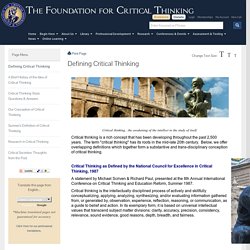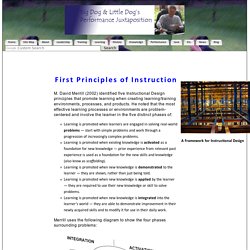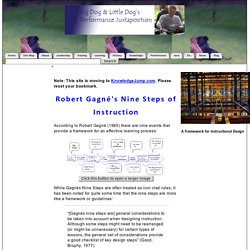

2017 Webinar: The OSCQR Rubric: Course Quality Review. The OSCQR Process – OSCQR – Open SUNY Course Quality Review Rubric. The OSCQR Process provides a Framework and Dashboard that supports a campus-tailored and scalable approach to improving the instructional design of online or blended courses.

The Framework includes: A Course Review that results in an Action Plan to improve the design of the online course.The Course Refresh prioritizes and targets specific improvements suggested in the Action Plan for improvements.A Learning Review that identifies and determines the next set of improvements for continuous online course quality improvement. Handbook_OpenSUNY+CourseReview@MCC(1).pdf. Bielaczyc. Mihaly Csikszentmihalyi: Flow, the secret to happiness. Edward Deci - Self-Determination Theory. John M. Keller's ARCS Motivational Design Model explained. Mayer's Theory of Multimedia Learning. Online Collaborative Learning Theory. Summarizing the Community of Inquiry Model.
a8fbbde231371203fa6b389bf6084660bf3e. TuOCLCCh2. 4.4 Online collaborative learning. 4.4.1 What is online collaborative learning? The concurrence of both constructivist approaches to learning and the development of the Internet has led to the development of a particular form of constructivist teaching, originally called computer-mediated communication (CMC), or networked learning, but which has been developed into what Harasim (2012) now calls online collaborative learning theory (OCL). She describes OCL as follows (p. 90): OCL theory provides a model of learning in which students are encouraged and supported to work together to create knowledge: to invent, to explore ways to innovate, and, by so doing, to seek the conceptual knowledge needed to solve problems rather than recite what they think is the right answer.
From the very early days of online learning, some instructors have focused heavily on the communication affordances of the Internet (see for instance, Hiltz and Turoff, 1978). 4.4.2 Core design principles of OCL 4.4.3 Community of Inquiry 4.4.8 Summary 1. 2. 3. Inductive%28JCST%29. - Critical Thinking Model 1. To Analyze Thinking We Must Identify and Question its Elemental Structures Standard: Clarityunderstandable, the meaning can be grasped Could you elaborate further?

Could you give me an example? Could you illustrate what you mean? Standard: Accuracyfree from errors or distortions, true How could we check on that? Critical Thinking and Problem-solving. Defining Critical Thinking. It entails the examination of those structures or elements of thought implicit in all reasoning: purpose, problem, or question-at-issue; assumptions; concepts; empirical grounding; reasoning leading to conclusions; implications and consequences; objections from alternative viewpoints; and frame of reference.

Critical thinking — in being responsive to variable subject matter, issues, and purposes — is incorporated in a family of interwoven modes of thinking, among them: scientific thinking, mathematical thinking, historical thinking, anthropological thinking, economic thinking, moral thinking, and philosophical thinking. Critical thinking can be seen as having two components: 1) a set of information and belief generating and processing skills, and 2) the habit, based on intellectual commitment, of using those skills to guide behavior. Critical thinking varies according to the motivation underlying it. TEDxWilliamsport - Dr. Derek Cabrera - How Thinking Works.
CERE12-13: Combined student wikis. Deep and Surface Learning: The Literature Tell me, I forget.

Show me, I remember. Involve me, I understand. - Confucius What is Below? If You Only Read One Paper, Make it This. Layout 1 - 1409Advocateforweb. Summaries of Learning Theories and Models - Learning Theories. Videos: Learning Theories, Instructional Design Theories, & Instructional Design Models. Instructional or Learning Design. What is known as “sequencing” and organizing “epitomes” in Reigeluth's Elaboration theory, is commonly referred to as “chunking”—configuring large amounts of information into smaller units of information that are scaffolded (supportive structures) in order to accommodate memory and learning limitations.

For example, “Instructional Design” is chunked or epitomized into analysis, design, development, Implementation, & evaluation. Developing instruction (Instructional Design) is divided into several theories and a model (at least on this site). Notice how we took a complex subject and chunked it into small, bite size pieces. Charles Reigeluth was a doctorate student of Merrill. He used a sequencing approach that is consistent with Merrill's Component Display Theory (that is, each theory enhances the other). This zoom lens approach first looks at the subject through a wide-angle lens. As we continue to zoom, we go into great detail with each iteration or layering. 1. Prechunks ↓ Elaboration ↓ First Principles of Instruction. M.

David Merrill (2002) identified five Instructional Design principles that promote learning when creating learning/training environments, processes, and products. He noted that the most effective learning processes or environments are problem-centered and involve the learner in the five distinct phases of: Learning is promoted when learners are engaged in solving real-world problems — start with simple problems and work through a progression of increasingly complex problems. Learning is promoted when existing knowledge is activated as a foundation for new knowledge — prior experience from relevant past experience is used as a foundation for the new skills and knowledge (also know as scaffolding). Learning is promoted when new knowledge is demonstrated to the learner — they are shown, rather than just being told.
Merrill uses the following diagram to show the four phases surrounding problems: Robert Gagné's Nine Steps of Instruction. According to Robert Gagné (1985) there are nine events that provide a framework for an effective learning process: While Gagnés Nine Steps are often treated as iron clad rules, it has been noted for quite some time that the nine steps are more like a framework or guidelines: “[Gagnés nine steps are] general considerations to be taken into account when designing instruction.

Although some steps might need to be rearranged (or might be unnecessary) for certain types of lessons, the general set of considerations provide a good checklist of key design steps” (Good, Brophy, 1977). The Nine Steps 1. Storytelling Demonstrations Presenting a problem to be solved Identifying why it is important to them Wick, Pollock, Jefferson, and Flanagan (2006) describe how the research also supports extending the interest device into the workplace in order to increase performance when the learners apply their new skills to the job. 2. 3. 4. 5. 6. In addition, demonstrate as required (modeling). 7. 8. Learning Theories.
Tagging Library.
Instructional Design. Online Teaching Tools & Resources. OER.